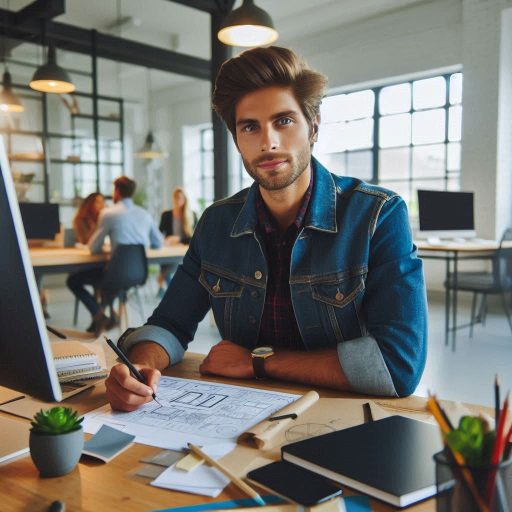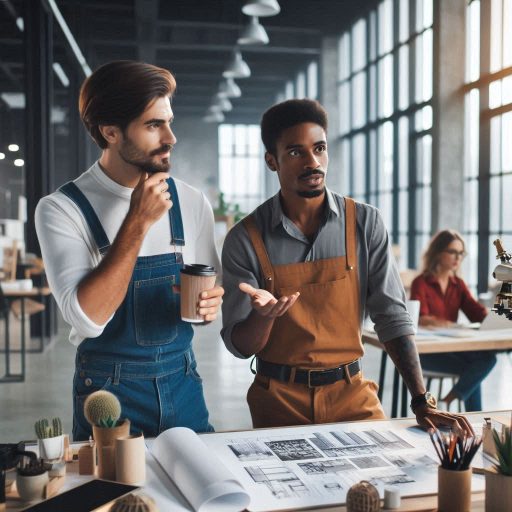Introduction
Acing an exhibition design interview is crucial for your career in this vibrant field.
These interviews not only assess your creativity but also gauge your technical skills and problem-solving abilities.
The exhibition design industry is highly competitive, with many talented professionals vying for the same positions.
Therefore, standing out from the crowd is essential to secure your dream job.
Employers seek candidates who can blend innovative ideas with practical execution.
They want to see how you approach design challenges and translate concepts into engaging experiences.
A strong interview can open doors to exciting projects and collaborations, allowing you to work with prestigious brands and organizations.
Success in this field often leads to career advancement and recognition within the industry.
Many exhibition designers grow into leadership roles or specialize in niche areas, enhancing their expertise.
Prepare thoroughly to demonstrate your knowledge and passion.
Showcase your portfolio effectively and be ready to discuss your design process in detail.
Highlight your experiences, emphasizing how they shaped your design philosophy.
Aim high, and your hard work will pay off in this dynamic and rewarding industry.
Research the Company
Understand the Company’s Values and Design Style
When preparing for an exhibition design interview, one of the most crucial steps is to thoroughly research the company.
Understanding the company’s values and design style is vital in aligning your approach with what they seek in a candidate.
Begin by visiting their website and exploring their mission statement.
This statement often encapsulates their core values and design philosophy.
Consider how their mission aligns with your own professional beliefs and experiences.
Additionally, take note of their brand identity.
Look at their logo, color schemes, and typography.
Understanding these elements will help you appreciate their design language.
For example, if a company emphasizes sustainability, consider how your work can contribute to that ethos.
Reflecting on these aspects during the interview will demonstrate your alignment with their vision.
Familiarize Yourself with Their Previous Work
Familiarizing yourself with the company’s previous projects provides valuable insights into their design aesthetic and the types of exhibitions they typically handle.
Explore their portfolio and take note of key projects that highlight their style and strengths.
Pay attention to recurring themes, materials, and techniques they employ.
Analyzing these projects will allow you to identify how your skills and experiences can enhance their future endeavors.
For instance, if you notice they frequently use interactive elements, consider discussing how your experience in integrating technology can add value to their work.
This preparation not only equips you with talking points but also shows that you are proactive and engaged.
Show That You Did Your Homework During the Interview
During the interview, show that you’ve done your homework.
Reference specific projects or accomplishments of the company.
Choose those that resonate with you.
This could be a successful exhibition they designed or an innovative approach they took that inspired you.
By citing these examples, you signal to the interviewer that you are genuinely interested in the opportunity and committed to contributing to their team.
Moreover, ask insightful questions about their projects.
This could involve inquiries about the challenges they faced in specific exhibitions or how they measure the success of their designs.
Engaging in this manner not only shows your preparation but also your eagerness to learn and grow within the company.
Effective research is a cornerstone of a successful interview.
To position yourself as a strong candidate, understand the company’s values and design style.
Familiarize yourself with their previous work. Demonstrate your knowledge during the interview.
This preparation reflects your commitment and passion for the role, increasing your chances of making a lasting impression.
Read: How to Create Memorable Characters: Pro Tips
Prepare Your Portfolio
Select Your Best Work
Before heading to your interview, invest time in reviewing your past projects.
This critical step allows you to select pieces that not only showcase your talent and experience but also highlight your growth as a designer.
Choose work that aligns with the company’s aesthetic and design philosophy.
This alignment demonstrates to the interviewer that you understand their brand values and can contribute effectively to their team.
Look for projects that reflect innovation, creativity, and technical skill.
Include a diverse range of work that showcases your expertise.
Highlight striking exhibition designs, well executed branding projects, and interactive installations.
Each piece should tell a story about your design journey and your ability to solve problems creatively.
Digital and Physical Copy
In today’s digital age, having both a digital and physical copy of your portfolio is essential.
Your digital portfolio offers the convenience of being easily shared via email or online platforms, making it accessible for remote discussions or follow-ups after the interview.
Ensure that your digital portfolio is organized, visually appealing, and optimized for easy navigation.
Incorporate high-quality images and consider including video presentations or interactive elements to engage viewers.
Conversely, a physical copy allows for a more hands-on and interactive experience during the interview.
This tactile engagement can leave a lasting impression and foster deeper discussions about your work.
Ensure your physical portfolio is professionally presented, using high-quality materials to reflect your design sensibility.
Include printed images, sketches, and detailed descriptions to provide context.
Both versions should be up to date, showcasing your best and most relevant work.
Practice Presenting Your Work
Confidence is key when presenting your portfolio during an interview.
To build this confidence, practice discussing each project thoroughly.
Focus on key details such as design choices, objectives, and challenges faced throughout the process.
Be prepared to explain your design rationale, including how you approached each project and the methodologies you employed.
Anticipate questions about your process, inspiration, and any feedback you received, and think through your responses in advance.
Rehearsing your presentation will help you articulate your thoughts clearly and showcase your expertise effectively.
Remember, the way you present your work can be just as important as the work itself.
A well-rehearsed presentation will convey professionalism and leave a positive impression on the interviewer.
Final Thoughts
Your portfolio is a powerful reflection of your skills and creativity as a designer.
Ensure it is organized, easy to navigate, and visually appealing.
Tailor your selection of work to align closely with the company’s aesthetic, reinforcing your understanding of their brand identity.
Have both digital and physical copies ready to cater to different presentation contexts.
Finally, practice presenting your projects with confidence to effectively communicate your design vision and problem-solving capabilities.
With a well-prepared portfolio, you’ll be one step closer to acing your exhibition design interview and demonstrating your potential as a valuable team member.
Brush Up on Technical Skills
Be Prepared to Discuss Software and Tools Used in Exhibition Design
When preparing for an exhibition design interview, honing your technical skills is crucial.
Exhibitions demand a comprehensive understanding of various software and tools that bring your creative vision to life.
Here’s an expanded guide on key areas to focus on:
Software and Tools
Familiarizing yourself with popular design software is essential.
Key tools in the exhibition design industry include:
- AutoCAD: Renowned for drafting and creating detailed floor plans.
Discuss specific projects where you utilized AutoCAD to streamline your design process and enhance accuracy. - SketchUp: Ideal for 3D modeling, this software allows for quick visualizations.
Share how you have employed SketchUp to develop concepts and engage clients with realistic models.
Prepare to elaborate on how you have integrated these tools into your workflow, emphasizing their impact on the efficiency and effectiveness of your designs.
3D Modeling
3D modeling is a cornerstone of exhibition design, crucial for creating immersive and realistic environments.
Focus on the following:
- Demonstrate Expertise: Be prepared to discuss your proficiency in 3D modeling software.
Highlight any specific techniques you use to enhance your models, such as texture mapping or lighting. - Workflow Overview: Outline your typical workflow, from conceptualization to the final 3D model.
Explain how you gather client feedback and iterate on designs to refine your vision.
Drafting and Rendering
Your ability to draft and render effectively is critical for presenting detailed plans and visualizations to clients.
Consider these points:
- Drafting Techniques: Explain your approach to drafting detailed plans.
Discuss how your drafting style supports clarity and accuracy in conveying ideas. - Rendering Skills: Share your rendering techniques, highlighting how you create realistic visualizations.
Mention any software-specific capabilities, such as photorealistic rendering in V-Ray or Lumion.
Special Skills and Certifications
Highlight any special skills or certifications that distinguish you from other candidates.
These could include:
- Interactive Exhibit Design: If you have experience with interactive displays or augmented reality, be sure to discuss this.
Explain how these elements enhance visitor engagement and contribute to the overall experience. - Certifications: Mention any relevant certifications, such as LEED accreditation or specific software certifications.
These qualifications can demonstrate your commitment to professional development and industry standards. - Soft Skills: Don’t overlook the importance of soft skills.
Communication, teamwork, and project management are vital in exhibition design.
Share examples of how you effectively collaborated with cross-functional teams to achieve project goals.
Showcase your technical skills and expertise in exhibition design.
This demonstrates to potential employers your ability to meet role demands.
Highlight your capability to provide innovative solutions for their projects.
Remember to practice discussing your technical skills clearly and concisely.
Articulating your abilities effectively during the interview will enhance your chances of making a positive impression on your interviewers.
Prepare to answer questions thoughtfully and demonstrate how your technical competencies align with the needs of the exhibition design industry.
Read: Ceramic Art Exhibitions to Visit in 2024
Practice Interview Questions
Anticipating interview questions can significantly boost your confidence and performance.
Practicing potential questions helps you articulate your experience, design process, and problem-solving skills effectively.
Here are some key tips on how to prepare for exhibition design interview questions
Transform Your Career Today
Unlock a personalized career strategy that drives real results. Get tailored advice and a roadmap designed just for you.
Start NowAnticipate Common Interview Questions
Research common interview questions related to exhibition design roles.
Expect questions about your design experience, project management skills, and approach to problem-solving.
Prepare to discuss your past projects, how you handle deadlines, and your design philosophy.
Anticipate technical questions about the design software you use and how you collaborate with teams.
Being prepared for these questions shows you are proactive and well-organized.
Highlighting Your Design Process
Interviewers often ask about your design process to understand how you approach challenges.
Be ready to walk through a specific project, detailing each stage from concept to execution.
Highlight your brainstorming methods, use of sketches or digital tools, and how you incorporate client feedback.
Share examples of how you solved unexpected issues during a project.
This demonstrates your adaptability and ability to think critically under pressure.
Showcase Problem-Solving Skills
Exhibition design requires quick thinking and adaptability.
Prepare to discuss scenarios where you faced design constraints or budget limitations.
Explain how you navigated these challenges to deliver successful outcomes.
Use specific examples to highlight your resourcefulness and creative solutions.
Interviewers value designers who can think on their feet and make informed decisions that enhance the final exhibition.
Preparing Thoughtful Responses
When preparing your answers, focus on crafting clear, concise, and thoughtful responses that reflect your expertise.
Use the STAR method (Situation, Task, Action, Result) to structure your answers and ensure they are impactful.
This approach helps you stay focused and ensures your responses are relevant.
Practice explaining your design choices and how they align with the client’s objectives and audience needs.
Practice with a Friend or Mentor
Practicing with a friend, mentor, or colleague helps you refine your answers and receive valuable feedback.
Choose someone familiar with the design industry to simulate a realistic interview environment.
Ask them to provide honest feedback on your responses, body language, and overall communication style.
This practice helps you identify areas of improvement and boosts your confidence.
Record and Review Your Practice Sessions
Recording your practice sessions allows you to review your performance and identify any nervous habits or areas needing refinement.
Pay attention to your tone, pace, and how effectively you convey your ideas.
Adjust your responses as needed to ensure you are presenting your best self.
Continuous practice and review help you master the art of clear and confident communication.
Preparing for exhibition design interviews requires anticipating questions, refining your responses, and practicing extensively.
By focusing on common questions, showcasing your problem-solving skills, and rehearsing with a mentor, you can significantly enhance your interview performance.
Practice makes perfect, so invest the time to prepare thoroughly and ace your next exhibition design interview.
Read: Character Design Trends: What’s Hot in 2024?

Show Your Collaborative Skills
Highlight Your Experience Working in Teams on Past Projects
Working effectively within a team is crucial in exhibition design, where the success of a project often depends on the collective effort of various professionals.
Demonstrating your teamwork experience is not just about mentioning that you worked with others; it’s about showing how you contributed to the team’s success.
Provide specific examples of projects where you collaborated closely with others.
For instance, discuss a past project where you were part of a multidisciplinary team that included designers, architects, marketers, and technicians.
Describe the project’s scope and your role in it, highlighting how your contributions directly impacted the final outcome.
For a recent museum exhibition project, you conceptualized the layout and coordinated with graphic designers.
You ensured the visual elements aligned with the overall theme.
Describe how you facilitated communication between team members, managed timelines, and helped integrate various elements into a cohesive design.
Emphasize your adaptability by taking on tasks beyond your role, like troubleshooting or handling last-minute changes.
Step in willingly to assist with technical issues when needed. Show readiness to help with unexpected challenges.
Illustrate Your Ability to Communicate and Collaborate Effectively with Others
Effective communication is the backbone of successful teamwork, particularly in exhibition design, where precision and clarity are essential.
Describe your communication style, emphasizing how you ensure all team members are aligned on the project’s vision and objectives.
Highlight your proficiency in using communication tools, such as project management software, to keep the team updated and organized.
Share how you maintain open lines of communication, regularly checking in with team members and encouraging feedback.
Provide examples of situations where you had to mediate conflicts within the team, showcasing your conflict resolution skills.
For instance, discuss a scenario where a disagreement arose between the creative and technical teams regarding the feasibility of a design element.
Explain how you facilitated a constructive dialogue, helping each side understand the other’s perspective, and ultimately led the team to a consensus.
Highlighting these skills demonstrates your ability to foster a collaborative environment where all voices are heard and respected.
How You Contribute to a Positive and Productive Work Environment
A positive work environment can significantly impact team productivity and morale.
Highlight how you contribute to fostering such an atmosphere, whether through maintaining a positive attitude.
Offering support to team members, or organizing team-building activities.
Explain how you motivate others by recognizing their strengths, celebrating successes, and offering encouragement during challenging times.
Showcase your leadership skills by discussing any initiatives you have taken to improve teamwork within a project.
For example, you might have introduced a new collaborative tool that streamlined communication or suggested regular team check-ins to keep everyone aligned.
Highlight your ability to adapt to different team dynamics, demonstrating your emotional intelligence and understanding of various personalities and work styles.
Describe how you handle working with team members who have different approaches.
Emphasizing your flexibility and willingness to adjust your communication style to fit the needs of the team.
By sharing these experiences, you’ll illustrate your ability to maintain a harmonious work environment that encourages creativity, collaboration, and high performance.
Showcase your collaborative skills in an exhibition design interview to highlight your talent and teamwork.
This approach demonstrates you are not just a skilled designer but also a valuable team player.
Provide specific examples of your past experiences, highlighting how your ability to work effectively with others has contributed to successful projects.
Showcase your skills in communication, conflict resolution, and leadership, and emphasize your commitment to creating a positive and productive work environment.
These attributes will set you apart as a designer who excels in both individual creativity and collaborative teamwork, making you an asset to any exhibition design team.
Read: How to Price Your Ceramic Artwork
Demonstrate Your Creativity
Discuss Your Design Process and Inspirations
Start by providing insights into your design process. Describe how you tackle a project from concept development to final execution.
Explain the steps you take, such as brainstorming, sketching, and prototyping.
This will not only illustrate your methodical approach but also highlight your creative journey.
Key Points to Address
- Initial Concept Development: Discuss how you generate ideas.
Do you brainstorm solo or collaborate with others. - Sources of Inspiration: Share what inspires your designs.
It could be nature, art movements, architectural styles, or even daily life.
Mention specific experiences or observations that influenced your work. - Iterative Process: Explain how you refine your ideas through feedback and revisions, showcasing your adaptability and open-mindedness.
Push Boundaries and Think Outside the Box
Highlight your willingness to push creative boundaries.
Discuss moments when you adopted an unconventional approach to a design problem.
Examples to Consider
- Unique Solutions: Talk about instances where you implemented non-traditional materials or layouts.
For instance, if you used recycled materials creatively, explain how it impacted both aesthetics and sustainability. - Challenging Norms: Share experiences where you deviated from standard practices to create something fresh.
This could include innovative use of space or unexpected color schemes.
By illustrating these experiences, you will convey your ability to think critically and creatively under pressure.
Bring Examples of Innovative Solutions
Prepare tangible examples of innovative solutions you’ve implemented in previous projects.
Use a novel presentation method to showcase your creativity.
Employ inventive materials to enhance your project.
Include engaging interactive elements for a dynamic experience.
Concrete examples can effectively demonstrate your creative prowess.
What to Include
- Project Portfolio: Bring visuals sketches, photographs, or digital presentations that highlight your work.
Visual aids make your ideas more accessible and memorable. - Specific Projects: Describe a project where your creative input significantly altered the outcome.
For instance, explain how an interactive display enhanced audience engagement and left a lasting impression. - Metrics of Success: If possible, share results or feedback that underscore the success of your innovative designs.
This could be audience attendance figures, surveys, or client testimonials.
Demonstrating creativity during your exhibition design interview is essential for making a strong impression.
Articulate your design process clearly.
Showcase how you push creative boundaries.
Present concrete examples of innovative solutions.
This approach positions you as a standout candidate.
Prepare thoroughly, and let your passion for design shine through.
Ultimately, your unique perspective and creative abilities will be key factors in securing the position you desire.
Ask Thoughtful Questions
Prepare Insightful Questions to Ask the Interviewer
- Company Projects and Future Goals: Develop a list of thoughtful questions about the company’s current projects and future objectives.
For instance, ask about upcoming initiatives or how the organization plans to navigate industry changes.
Questions like, “What are the key projects the team is currently focused on.” show your genuine interest in their work. - Team Dynamics and Collaboration: Inquire about how teams collaborate within the organization.
Understanding team structure and dynamics can give you insight into the work environment.
You might ask, “How does the team approach collaboration on complex projects.” - Challenges Facing the Company: Asking about challenges demonstrates your awareness of the industry’s complexities.
Questions such as, “What challenges is the company currently facing in the market.”
Indicate your proactive mindset and willingness to contribute solutions.
Show Your Interest in Learning and Growing Within the Organization
- Eagerness for Skill Development: Articulate your desire to develop skills that align with the company’s objectives.
You might say, “I’m eager to learn more about financial modeling techniques, as I know they are essential for this role.”
This shows that you are focused on growth and can adapt to the company’s needs. - Career Aspirations: Share your long-term career goals and how they align with the company’s vision.
For instance, “I aspire to take on leadership roles in financial analysis, and I believe your company offers the perfect environment for that growth.” - Personal Development Initiatives:Highlight specific initiatives you have taken for personal development.
Include relevant courses, certifications, or networking experiences.
These demonstrate your commitment to continuous improvement.
Engage in a Conversation that Demonstrates Your Curiosity and Enthusiasm
- Relevant Experiences: Share experiences that illustrate your passion for the industry.
For example, discuss a project you worked on that is relevant to the company’s work.
This not only shows your enthusiasm but also helps the interviewer see how you can contribute. - Discussion on Industry Trends: Use the interview as an opportunity to discuss recent trends or challenges in the financial services industry.
Asking for the interviewer’s perspective on these topics fosters a more engaging dialogue and showcases your industry knowledge. - Fostering Dialogue: Encourage a two-way conversation by actively listening and responding to the interviewer’s comments.
This not only demonstrates your curiosity but also helps build rapport.
Phrases like, “That’s interesting could you elaborate on that” can help deepen the conversation.
Preparing for a financial services interview involves thorough research, thoughtful questions, and a genuine interest in the organization.
By engaging in meaningful conversations and showcasing your enthusiasm for learning and growth, you can leave a lasting impression on your interviewer.
Conclusion
A successful exhibition design interview requires thorough preparation and strategic planning.
As we discussed, focusing on showcasing your creativity and problem-solving skills is essential.
Review your portfolio carefully and be ready to discuss the specific projects that highlight your expertise.
Practice common interview questions to boost your confidence and prepare for unexpected inquiries.
This preparation not only helps you articulate your thoughts clearly but also allows you to engage more meaningfully during the discussion.
Thorough preparation is crucial in a competitive field like exhibition design.
It helps you stand out from other candidates and demonstrates your commitment to the role.
Use these tips to impress potential employers and convey your passion for design.
Each interview is an opportunity for growth, so approach them as learning experiences.
By implementing these strategies, you can significantly enhance your interview performance.
Acing your next exhibition design interview could be the key to unlocking new career opportunities.
Embrace the journey, let your creativity shine, and take the next step toward your professional aspirations.
Your preparation and passion will set you apart and propel you forward in your career.




